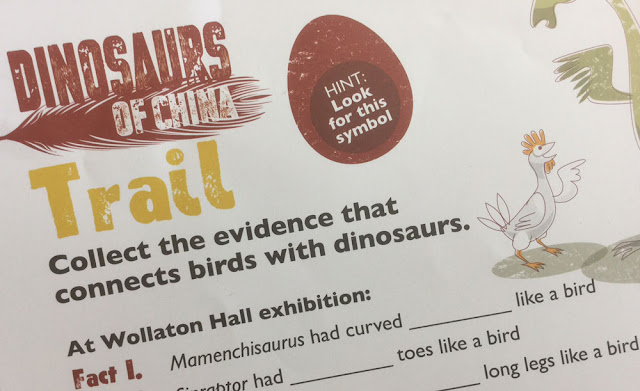 |
| George the Gorilla or Gorilla-saurus. |
George has been a feature of Wollaton Hall since 1926 so why give him a dinosaur makeover? There’s a rock and mineral gallery in Wollaton Hall, but no dinosaurs…
Ground shakers to feathered flyers

Mamenchisaurus fills Wollaton's Great Hall at about 23m long from head to tail,
but is taller than three double-decker buses when in this rearing posture.
Wollaton Hall is hosting the ‘Dinosaurs of China’ exhibition
that brings to life the story of how dinosaurs evolved into the birds that live
alongside us today. The new exhibition, which opened in July and runs until the
end of October, features fossils that have never been seen outside of Asia.
but is taller than three double-decker buses when in this rearing posture.
The exhibition includes the best-preserved dinosaur fossils from anywhere in the world, not just the bones, but also soft parts including skin and feathers. Many of the species on show are new science discoveries that were only named in the last 20 years.
The exhibition is simple and uncluttered with easy-to-read panels with bite-sized chunks of information to guide you through the story. I loved the use of the packing cases as plinths to lift the smaller dinosaurs off the ground.
Highlights of the exhibition include the Gigantoraptor, which at four metres high and eight metres long is the largest feathered dinosaur ever found; double decker buses are about four metres by eleven metres.
‘Flying’ dinosaurs include the Microraptor, which had flight feathers on its four limbs for gliding towards its intended prey. Measuring about a metre in length, the Microraptor is the largest four-winged dinosaur ever discovered - longer than today’s eagle or albatross.
 |
| Sinornithosaurus; a 'fuzzy raptor', about the size of a turkey. |
'Jurassic Park got it wrong!'
Large and deadly dinosaurs aside, I was particularly blown away by the preservation of the feathers in the fossils. Sinornithosaurus is labelled as 'a 'fuzzy-raptor' that proves Velociraptor had feathers', where you can clearly see the tuft-like feather structure.What happened next?
The Dinosaurs of China exhibit integrates well with the existing natural history collection of Wollaton Hall, where the evolutionary story continues and makes the bold statement 'Dinosaurs are not extinct; birds are dinosaurs!' We see some feathered dinosaurs and dinosaur eggs among Wollaton's collection of today's birds including a pelican, bird-of-paradise and red kite.
 |
| Sinraptor, not feathered, probably scaly and the size of a minibus. |
 |
| Collect the evidence that connects birds with dinosaurs. |
Education resources
If you were in any doubt about the connection between bird and dinosaurs, you could fill in the Dinosaurs of China trail sheet, they are available free on entry.Visiting schools
Schools can visit the exhibition for teacher-led sessions or the Hall's education team offer a wide range of facilitated sessions; from Mary Anning and her Fossils to Earth Science Dinosaur Day.
What about the rock and mineral gallery?
 |
| Jurassic Nottingham, the forthcoming geology exhibition theme for Wollalton Hall. |

Comments